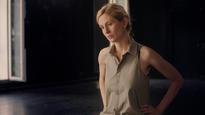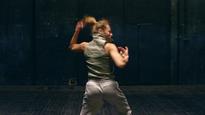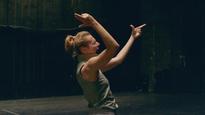APHASIA 3RD CHAPTER
The starting point of Jelena Jureša’s interest in the evolution of a narrative constituting the final episode of Aphasia is a single photograph, which is never shown in the work, but its presence is almost tangible, heavy, almost to the point of materialising before our eyes. We identify it in speech, we identify it in motion. It is heard, but not directly seen. Present in the spoken word, in the tension of the performer’s kicking foot, body torsion, and posture.
The subject is the famous and emblematic photograph taken by Ron Haviv in Bijeljina on 2 April 1992, at the very beginning of the war in Bosnia. The photo was amply distributed, described, and published. In Regarding the Pain of Others it was described by Susan Sontag; in Croatia, the same photograph is featured on book covers— the Croatian edition of Regarding the Pain of Others by Susan Sontag and They Would Never Hurt a Fly (Oni ne bi ni mrava zgazili) by Slavenka Drakulić, a book about how ordinary people committed terrible crimes in wartime in the territory of the former Yugoslavia. It is described cinematically by Godard in his short video essay Je vous salue Sarajevo (1993). On a completely different, specific and functional level, on the level of forensics, the photo served as evidence at the International Tribunal in The Hague and the perpetrator was left unpunished. In Aphasia the photograph is described through the words of Barbara Matejčić, a research journalist and protagonist of this work. Her spoken words connect the past and the present, face us with the scene from Bijeljina and its consequences, the question ‘I wonder how much they know’ untangles an entire web of relations and responsibilities.
The central place of forming a visual narrative is held by a juxtaposition between two scenes of related elements of formal visual language acting in a correlation both as the same and as different. Both outline a female character, a young woman with fair hair, dressed in an olive-green shirt. The scenes are set in a relatively neutral black box, occasionally with a touch of suspense, two scenes in a visual dialogue—one shows a woman from behind in a performance, her corporeal motions are both fluid and tense, and the other portrays her en face, sitting, performing a monologue which seems to stem from the documentary interview method, or a testimony in the first person singular. Slowly we identify the parallels between the scenes acting as doppelgangers. Through different visual languages and formal tools, they speak about the same thing. Through visual translation we feel how the performance movement emphasizes or implies the content of the uttered. In this appropriation of an image which is not here, but is nevertheless present all the time like a spectre, the mimesis of the performative part constructs itself as a substitute for the missing scene. It is in the performance movement of Ivana Jozić that we identify the unstable permanence of the scene which appears like a ghost, fluid like a memory.




- Format DIGITAL FILE(DIGITAL FILE)
- Color system PAL
- Color col.
- Year 2019
- Duration 00:45:00
- Languageinfo
Subtitles: English UK
Spoken: Croatian, English UK
-
Artists